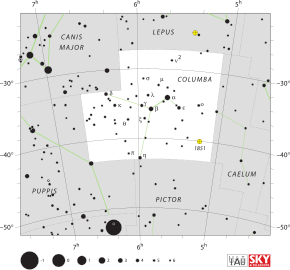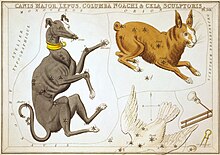| Constellation | |
 List of stars in Columba List of stars in Columba | |
| Abbreviation | Col |
|---|---|
| Genitive | Columbae |
| Pronunciation | /kəˈlʌmbə/, genitive /kəˈlʌmbiː/ |
| Symbolism | the dove |
| Right ascension | 05 03 53.8665–06 39 36.9263 |
| Declination | −27.0772038°–−43.1116486° |
| Area | 270 sq. deg. (54th) |
| Main stars | 5 |
| Bayer/Flamsteed stars | 18 |
| Stars with planets | 1 |
| Stars brighter than 3.00 | 1 |
| Stars within 10.00 pc (32.62 ly) | 0 |
| Brightest star | α Col (Phact) (2.65) |
| Messier objects | 0 |
| Meteor showers | 0 |
| Bordering constellations | Lepus Caelum Pictor Puppis Canis Major |
| Visible at latitudes between +45° and −90°. Best visible at 21:00 (9 p.m.) during the month of January. | |
Columba is a faint constellation designated in the late sixteenth century, remaining in official use, with its rigid limits set in the 20th century. Its name is Latin for dove. It takes up 1.31% of the southern celestial hemisphere and is just south of Canis Major and Lepus.
History

- Early 3rd century BC: Aratus's astronomical poem Phainomena (lines 367–370 and 384–385) mentions faint stars where Columba is now but does not fit any name or figure to them.
- 2nd century AD: Ptolemy lists 48 constellations in the Almagest. While Columba is not yet among them, several stars south of Canis Major listed in this work will eventually become part of Columba.
- c. 150–215 AD: Clement of Alexandria wrote in his Logos Paidogogos"Αἱ δὲ σφραγῖδες ἡμῖν ἔστων πελειὰς ἢ ἰχθὺς ἢ ναῦς οὐριοδρομοῦσα ἢ λύρα μουσική, ᾗ κέχρηται Πολυκράτης, ἢ ἄγκυρα ναυτική," (= ", let our seals be a dove or a fish or a ship running in a good wind or a musical lyre ... or a ship's anchor ..."), with no mention of stars or astronomy.
- 1592 AD: Petrus Plancius first depicted Columba on the small celestial planispheres of his large wall map to differentiate the 'unformed stars' of the large constellation Canis Major. Columba is also shown on his smaller world map of 1594 and on early Dutch celestial globes. Plancius named the constellation Columba Noachi ("Noah's Dove"), referring to the dove that gave Noah the information that the Great Flood was receding. This name is found on early 17th-century celestial globes and star atlases.

- 1603: Frederick de Houtman listed Columba as "De Duyve med den Olijftack" ("the dove with the olive branch")
- 1603: Bayer's sky atlas Uranometria was published. It includes Columba as Columba Noachi.
- 1624: Bartschius listed Columba in his Usus Astronomicus as "Columba Nohae".
- 1662: Caesius published Coelum Astronomico-Poeticum, including an inaccurate Latin translation of the above text of Clement of Alexandria: it mistranslated "ναῦς οὐριοδρομοῦσα" as Latin "Navis coelestis cursu in coelum tendens" ("Ship of the sky following a course in the sky"), perhaps misunderstanding "οὐριο-" as "up in the air or sky" by analogy with οὐρανός = "sky".
- 1679: Halley mentioned Columba in his work Catalogus Stellarum Australium from his observations on St. Helena.
- 1679: Augustin Royer published a star atlas that showed Columba as a constellation.
- c.1690: Hevelius's Prodromus Astronomiae showed Columba but did not list it as a constellation.
- 1712 (pirated) and 1725 (authorized): Flamsteed's work Historia Coelestis Britannica showed Columba but did not list it as a constellation.
- 1757 or 1763: Lacaille listed Columba as a constellation and catalogued its stars.
- 1889: Richard H. Allen, misled by Caesius's mistranslation, wrote that the Columba asterism may have been invented in Roman/Greek times, but with a footnote saying that it may have been another star group.
- 2019: OSIRIS-REx students discovered a black hole in the constellation Columba, based on observing X-ray bursts.
Features
Stars
See also: List of stars in ColumbaColumba is rather inconspicuous with the brightest star, Alpha Columbae, being only of magnitude 2.7. This, a blue-white star, has a pre-Bayer, traditional, Arabic name Phact (meaning ring dove) and is 268 light-years from Earth. The only other named star is Beta Columbae, which has the alike-status name Wazn. It is an orange-hued giant star of magnitude 3.1, 87 light-years away. The constellation contains the runaway star μ Columbae. Exoplanet NGTS-1b and its star NGTS-1 are in Columba.
General radial velocity
Columba contains the solar antapex – the opposite to the net direction of the solar system
Deep-sky objects
The globular cluster NGC 1851 appears in Columba at 7th magnitude in a far part of our galaxy at 39,000 light-years away - it is resolvable south of at greatest latitude +40°N in medium-sized amateur telescopes (under good conditions).
See also
Citations
- ^ "Columba, constellation boundary". The Constellations. International Astronomical Union. Retrieved 27 February 2014.
- Ridpath, Ian., Star Tales online edition
- Brenda Deen Schildgen (2016). Heritage or Heresy: Preservation and Destruction of Religious Art and Architecture in Europe. Springer. p. 63. ISBN 978-0-230-61315-7.
- Ridpath & Tirion 2001, pp. 120–121.
- Ley, Willy (December 1963). "The Names of the Constellations". For Your Information. Galaxy Science Fiction. pp. 90–99.
- Canis Maior and Columba in Bayers Uranometria 1603 (Linda Hall Library) Archived 2007-04-27 at the Wayback Machine
- Richard H. Allen (1899) Star Names: Their Lore and Meaning, pp. 166–168
- "NASA's OSIRIS-REx Students Catch Unexpected Glimpse of Newly Discovered Black Hole". NASA. 28 February 2020.
- ^ Ridpath & Tirion 2017, p. 122.
- Madore, Barry F. (14 August 2002). "Astronomical Glossary". NASA/IPAC Extragalactic Database. Retrieved 31 January 2023.
References
- Makemson, Maud Worcester (1941). The Morning Star Rises: an account of Polynesian astronomy. Yale University Press. p. 281. Bibcode:1941msra.book.....M.
- Ridpath, Ian; Tirion, Wil (2001), Stars and Planets Guide, Princeton University Press, ISBN 0-691-08913-2
- Ridpath, Ian; Tirion, Wil (2017). Stars and planets guide (Fifth ed.). London: Collins. ISBN 978-0-00-823927-5. Princeton University Press, Princeton. ISBN 978-0-69-117788-5.
External links
- The Deep Photographic Guide to the Constellations: Columba
- The clickable Columba
- Star Tales – Columba
- Lost Stars, by Morton Wagman, publ. Mcdonald & Woodward Publishing Company, First printing September 2003, ISBN 0-939923-78-5 , page 110
| Constellation of Columba | |||||||||||
|---|---|---|---|---|---|---|---|---|---|---|---|
| Stars |
| ||||||||||
| |||||||||||
| |||||||||||
| Galaxies |
| ||||||||||